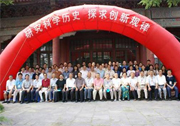| 中文题目: | (英文)清代中国湖南省桐木岭锌冶炼炉的数值模拟与对比研究 | ||||||
| 英文题目: | Numerical simulation and comparative study for the zinc smelting furnaces at the Tongmuling site in Qing Dynasty, Hunan Province, China | ||||||
| 作 者: | 黄兴,莫林恒,周文丽,罗胜强,肖亚,陈建立 | ||||||
| 刊物名称: | Advances in Archaeomaterials | ||||||
| 发表年度: | 2022-08-01 | ||||||
| 卷: | 3 | ||||||
| 期: | 1 | ||||||
| 页码: | 19-27 | ||||||
| 中文摘要: | Brass, which appears golden in color, used to be a valuable alloy in ancient times. During the Ming and Qing Dynasties, the Chinese used special furnaces to smelt zinc for minting and exporting to overseas in large quanti?ties. Archeological findings have revealed the overall structure of the zinc smelting furnaces at the Tongmuling site during the Qing Dynasty. In this study, computational fluid dynamics software was employed to simulate airflow fields within a furnace. Consequently, we observed that airflows were concentrated at the center of the lower chamber, after which they dispersed into the upper chamber through ceramic pads and finally were evenly distributed between the retorts. Increasing furnace height and improving thermal convection in the lower cham?ber helped increase the furnace temperature. The ceramic pads adjusted the airflow to ensure that temperature distribution in the upper chamber was uniform, and they supported burning in the upper chamber by preventing collapse. Compared with the heap smelting process recorded in Heavenly Creations and the large crucible furnaces used in modern times, zinc smelting furnaces at the Tongmuling site possess a unique structure. They serve as a link between preceding and subsequent technologies, offering important evidence for exploring the development of ancient Chinese zinc smelting technologies. | ||||||
| 英文摘要: | Brass, which appears golden in color, used to be a valuable alloy in ancient times. During the Ming and Qing Dynasties, the Chinese used special furnaces to smelt zinc for minting and exporting to overseas in large quanti?ties. Archeological findings have revealed the overall structure of the zinc smelting furnaces at the Tongmuling site during the Qing Dynasty. In this study, computational fluid dynamics software was employed to simulate airflow fields within a furnace. Consequently, we observed that airflows were concentrated at the center of the lower chamber, after which they dispersed into the upper chamber through ceramic pads and finally were evenly distributed between the retorts. Increasing furnace height and improving thermal convection in the lower cham?ber helped increase the furnace temperature. The ceramic pads adjusted the airflow to ensure that temperature distribution in the upper chamber was uniform, and they supported burning in the upper chamber by preventing collapse. Compared with the heap smelting process recorded in Heavenly Creations and the large crucible furnaces used in modern times, zinc smelting furnaces at the Tongmuling site possess a unique structure. They serve as a link between preceding and subsequent technologies, offering important evidence for exploring the development of ancient Chinese zinc smelting technologies. | ||||||





